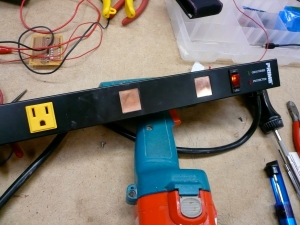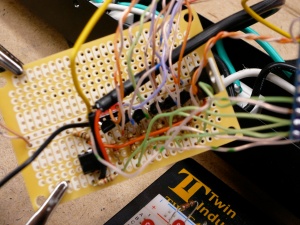/*
* Amp Delay circuit, based on ‘button’ by DojoDave <http://www.0j0.org>
*
* Control relays turning on power amps when input is detected on pin 2
* When input is gone (receiver off) the relays will turn off
*
*/
int relayPin1 = 6; // choose the pin for the RELAY
int relayPin2 = 12; // choose the pin for the RELAY
int relayPin3 = 11; // choose the pin for the RELAY
int relayPin4 = 10; // choose the pin for the RELAY
int relayPin5 = 9; // choose the pin for the RELAY
int relayPin6 = 8; // choose the pin for the RELAY
int inputPin = 7; // choose the input pin for receiver
int val = 0;
int val2 = 0; // variable for reading the pin status
int onToggle = 0; // variable so delays don’t occur every cycle
int offToggle = 0; // variable so delays don’t occur every cycle
int buttonState;
void setup() {
pinMode(relayPin1, OUTPUT); // declare relay as output
pinMode(relayPin2, OUTPUT); // declare relay as output
pinMode(relayPin3, OUTPUT); // declare relay as output
pinMode(relayPin4, OUTPUT); // declare relay as output
pinMode(relayPin5, OUTPUT); // declare relay as output
pinMode(relayPin6, OUTPUT); // declare relay as output
pinMode(inputPin, INPUT); // declare receiver as input
buttonState = digitalRead(inputPin); // read the initial state
}
void loop(){
val = digitalRead(inputPin); // read input value
delay(10);
val2 = digitalRead(inputPin); // read input value
if (val == val2) {
if (val !=buttonState) {
if (val == HIGH) { // check if the input is HIGH
if (onToggle == 0) {
onToggle = 1;
delay(200);
digitalWrite(relayPin1, HIGH); // turn relay ON
delay(200);
digitalWrite(relayPin2, HIGH); // turn relay ON
delay(200);
digitalWrite(relayPin3, HIGH); // turn relay ON
delay(200);
digitalWrite(relayPin4, HIGH); // turn relay ON
delay(200);
digitalWrite(relayPin5, HIGH); // turn relay ON
delay(200);
digitalWrite(relayPin6, HIGH); // turn relay ON
}
offToggle = 0;
}
else {
if (offToggle == 0) {
offToggle = 1;
delay(200);
digitalWrite(relayPin6, LOW); // turn relay OFF
delay(200);
digitalWrite(relayPin5, LOW); // turn relay OFF
delay(200);
digitalWrite(relayPin4, LOW); // turn relay OFF
delay(200);
digitalWrite(relayPin3, LOW); // turn relay OFF
delay(200);
digitalWrite(relayPin2, LOW); // turn relay OFF
delay(200);
digitalWrite(relayPin1, LOW); // turn relay OFF
}
onToggle = 0;
}
}
buttonState=val;
}
}




